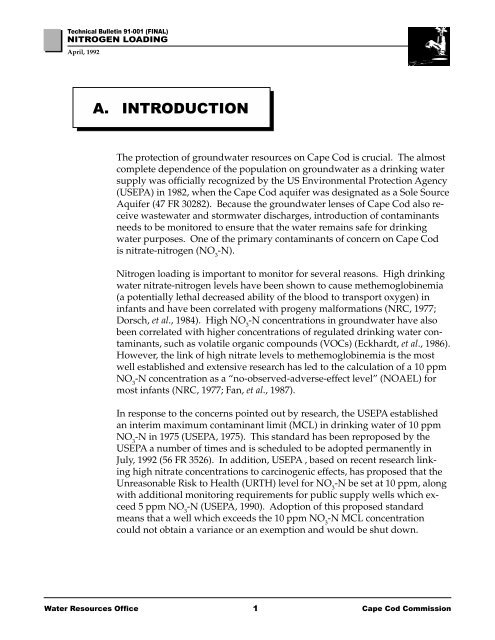Technical Bulletin 91-001 Nitrogen Loading - Cape Cod Commission
Technical Bulletin 91-001 Nitrogen Loading - Cape Cod Commission
Technical Bulletin 91-001 Nitrogen Loading - Cape Cod Commission
You also want an ePaper? Increase the reach of your titles
YUMPU automatically turns print PDFs into web optimized ePapers that Google loves.
<strong>Technical</strong> <strong>Bulletin</strong> <strong>91</strong>-<strong>001</strong> (FINAL)<br />
NITROGEN LOADING<br />
April, 1992<br />
A. INTRODUCTION<br />
The protection of groundwater resources on <strong>Cape</strong> <strong>Cod</strong> is crucial. The almost<br />
complete dependence of the population on groundwater as a drinking water<br />
supply was officially recognized by the US Environmental Protection Agency<br />
(USEPA) in 1982, when the <strong>Cape</strong> <strong>Cod</strong> aquifer was designated as a Sole Source<br />
Aquifer (47 FR 30282). Because the groundwater lenses of <strong>Cape</strong> <strong>Cod</strong> also receive<br />
wastewater and stormwater discharges, introduction of contaminants<br />
needs to be monitored to ensure that the water remains safe for drinking<br />
water purposes. One of the primary contaminants of concern on <strong>Cape</strong> <strong>Cod</strong><br />
is nitrate-nitrogen (NO 3<br />
-N).<br />
<strong>Nitrogen</strong> loading is important to monitor for several reasons. High drinking<br />
water nitrate-nitrogen levels have been shown to cause methemoglobinemia<br />
(a potentially lethal decreased ability of the blood to transport oxygen) in<br />
infants and have been correlated with progeny malformations (NRC, 1977;<br />
Dorsch, et al., 1984). High NO 3<br />
-N concentrations in groundwater have also<br />
been correlated with higher concentrations of regulated drinking water contaminants,<br />
such as volatile organic compounds (VOCs) (Eckhardt, et al., 1986).<br />
However, the link of high nitrate levels to methemoglobinemia is the most<br />
well established and extensive research has led to the calculation of a 10 ppm<br />
NO 3<br />
-N concentration as a “no-observed-adverse-effect level” (NOAEL) for<br />
most infants (NRC, 1977; Fan, et al., 1987).<br />
In response to the concerns pointed out by research, the USEPA established<br />
an interim maximum contaminant limit (MCL) in drinking water of 10 ppm<br />
NO 3<br />
-N in 1975 (USEPA, 1975). This standard has been reproposed by the<br />
USEPA a number of times and is scheduled to be adopted permanently in<br />
July, 1992 (56 FR 3526). In addition, USEPA , based on recent research linking<br />
high nitrate concentrations to carcinogenic effects, has proposed that the<br />
Unreasonable Risk to Health (URTH) level for NO 3<br />
-N be set at 10 ppm, along<br />
with additional monitoring requirements for public supply wells which exceed<br />
5 ppm NO 3<br />
-N (USEPA, 1990). Adoption of this proposed standard<br />
means that a well which exceeds the 10 ppm NO 3<br />
-N MCL concentration<br />
could not obtain a variance or an exemption and would be shut down.<br />
Water Resources Office 1<br />
<strong>Cape</strong> <strong>Cod</strong> <strong>Commission</strong>
















